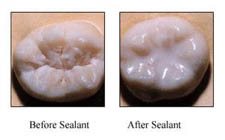WHAT ARE DENTAL SEALANTS?
Sealants are a plastic material that is placed in the pits and fissures of the chewing surfaces of your teeth, particularly the molars at the back because toothbrushes can’t reach all the way into the grooves to clean well.
WHO NEEDS DENTAL SEALANTS?
Kids are notoriously bad brushers and tend to ignore the problem areas in the back of the mouth that lead to cavities and decay, making them the prime target market for sealants. (However, if adults have certain problem areas that could be cured with sealants, this could be an option for them too.) The American Dental Association recommends that kids receive dental sealants as soon as their adult teeth erupt.
Those who are more susceptible to cavities and decay – whether that is because they are genetically prone to cavities, don’t have great oral hygiene habits, or lack access to dental care – should consider getting dental sealants as a preventative measure.
HOW DO DENTAL SEALANTS WORK?
Dental sealants fill in and smooth out the grooves and fissures in your teeth that tend to hide food particles and attract cavity-causing bacteria. According to the American Dental Association, sealants work by “’sealing out’ food and plaque; because toothbrush bristles cannot reach all the way into the depressions and grooves.”
HOW LONG DO DENTAL SEALANTS LAST?
Dental sealants can protect the teeth for up to 10 years, but need to be checked frequently by a dentist for cracks. If dental sealants are worn down, it’s possible for decay to get under the sealant.
ARE DENTAL SEALANTS EFFECTIVE?
Dental sealants have been shown to reduce the risk of cavities in the teeth that are covered. According to Jonathan Shenkin, a spokesman for the American Dental Association, decades of research demonstrate that coating the biting surface of 6-year molars with a resin-based sealant can reduce cavities by up to nearly 80% immediately, and up to 60% for four years or more.

